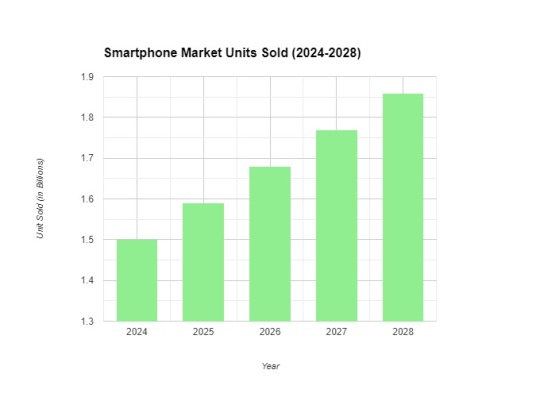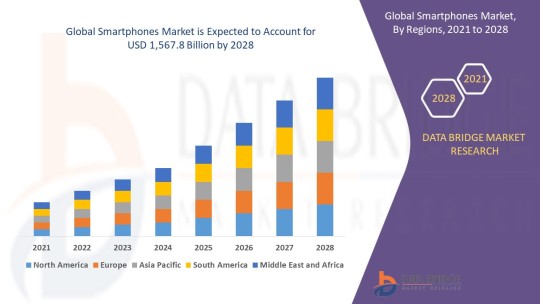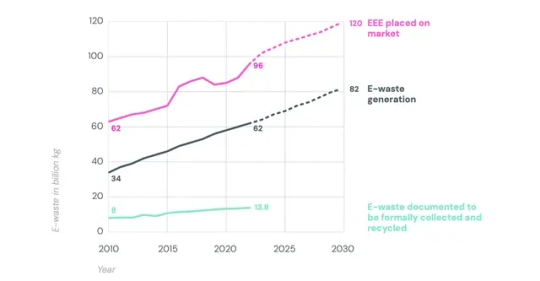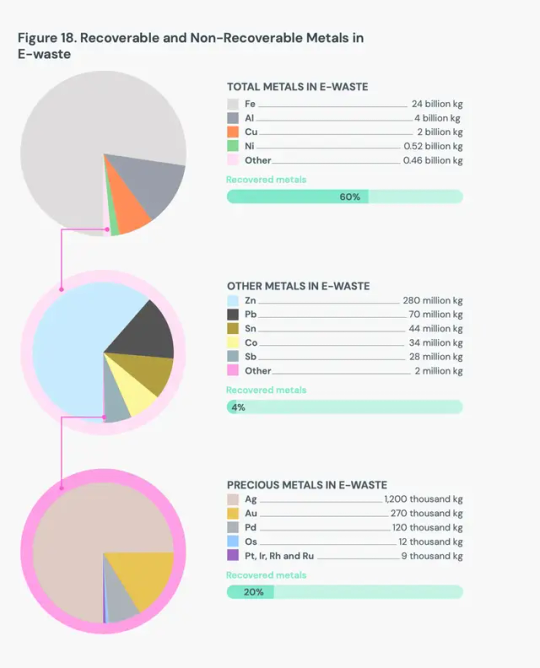#global smartphone market
Text
Exploring Size, Trends, and Outlook of the Smartphone Market
In the ever-evolving realm of technology, the smartphone market stands as a dynamic and pivotal player. As we delve into the smartphone market's size, growth, analysis, trends, and outlook, we witness an industry that continues to redefine itself in response to consumer demands and technological advancements.
Smartphone Market Size and Growth
The global smartphone market has experienced remarkable expansion over the years, driven by factors such as increased connectivity, rising disposable incomes, and a growing appetite for digital services. According to the latest statistics, the smartphone market size surpassed 1.5 billion units in 2023, reflecting a 5% year-on-year growth.

This expansion can be attributed to the relentless innovation in smartphone technology, with manufacturers constantly pushing boundaries to offer consumers devices equipped with cutting-edge features, enhanced performance, and improved user experiences.
Smartphone Market Analysis
A deeper dive into the smartphone industry reveals a nuanced landscape shaped by intense competition and rapid technological advancements. Market analysis indicates that Asia-Pacific remains a dominant force, accounting for over 40% of the global smartphone market share. China, in particular, emerges as a key player, both as a significant consumer and producer in the smartphone industry.
Additionally, the market is witnessing a shift towards mid-range and premium smartphones, as consumers increasingly seek devices that offer a balance between advanced features and affordability. This change is reflected in the market share data, with mid-range smartphones capturing around 35% of the global market, signaling a departure from the previous dominance of budget-friendly options.
Smartphone Market Trends
The smartphone market is marked by several trends that underscore the industry's adaptability to emerging consumer needs. One of the notable trends is the integration of 5G technology into smartphones. With the global rollout of 5G networks, smartphone manufacturers are racing to release 5G-compatible devices, expecting this trend to drive market growth in the coming years.
Another significant trend is the emphasis on sustainability and eco-friendly practices. Consumers are increasingly conscious of the environmental impact of technology, prompting smartphone manufacturers to adopt greener production methods and recyclable materials.
Smartphone Market Outlook
Looking ahead, the smartphone market outlook remains optimistic, fueled by ongoing technological advancements and the continued demand for smarter, more efficient devices. Industry experts project the global smartphone market to witness a CAGR of around 6% from 2024 to 2028, with an anticipated market size exceeding 1.8 billion units by the end of this period.
The outlook is particularly promising for markets in developing regions, where increasing urbanization and a growing middle class contribute to the rising demand for smartphones. However, manufacturers must remain vigilant and adaptable, considering the ever-changing consumer preferences and the potential impact of external factors, such as geopolitical events and economic uncertainties.
Conclusion
In conclusion, the smartphone market is a dynamic and robust industry that constantly reinvents itself to meet the evolving needs of consumers. With a global market size exceeding 1.5 billion units and a projected growth rate of 6%, the outlook is undeniably positive. As the market continues to evolve, key trends such as 5G integration and sustainability will play pivotal roles in shaping the industry's trajectory. The smartphone market stands as a testament to the relentless pursuit of innovation, ensuring that these pocket-sized devices remain indispensable in our increasingly connected world.
#market research#business#ken research#market analysis#market report#market research report#smartphone market#smartphone industry#global smartphone market#worldwide smartphone market share#smartphone market share#global smartphone market share#world smartphone market share#smartphone market outlook#global smartphone industry#global smartphone market growth#smartphone market analysis#smartphone market revenue#smartphone market trends#smartphone market size#smartphone sector
1 note
·
View note
Text
The Future of Consumer Electronics: Market Insights and Forecast

Stay ahead in the ever-evolving consumer electronics market. Explore the latest trends, growth opportunities, and innovative technologies shaping the industry. Be a part of the future of electronics.
#Audio Systems market#Home theater audio market trends#Bluetooth speaker market Size#Wireless audio device market#consumer electronics market#consumer electronics market share#drone camera market#Desktop Computers market#Laptop market size#computer accessories market#smart kitchen appliances market#Microwaves oven market#global air conditioner market#vacuum cleaners market#Lighting industry size#mobile phone market size#smartphone market size
1 note
·
View note
Text
listened to a keynote that had me shaking my head saying this is what no marxism does to a mf
#pro cap tech determinism like hellooo#the world could be fixed if everyone had access to smartphone and markets#the global south is suffering due to lack of market capitalism#what da hell
0 notes
Text
The Business Research Company offers smartphone processor market research report 2023 with industry size, share, segments and market growth
#smartphone processor market growth#smartphone processor market analysis#smartphone processor market share#smartphone processor market report#smartphone processor market segments#smartphone processor market size#smartphone processor market research#smartphone processor market forecast#smartphone processor market trends#global smartphone processor market
0 notes
Text
Xiaomi Revenue Falls 10 Percent in Third Quarter After Global Smartphone Market Shrinks
Xiaomi Revenue Falls 10 Percent in Third Quarter After Global Smartphone Market Shrinks
Xiaomi’s quarterly revenue fell almost 10 percent as it battled a slumping global smartphone market and weak consumer demand at home.
Sales of mobile devices fell 11 percent, leading declines across business divisions encompassing smart electronics and internet services. The Beijing-based company logged sales of CNY 70.5 billion (roughly Rs. 80,900 crore), slightly above estimates. But it posted…

View On WordPress
0 notes
Text
Smartphones Market Industry Share, Size, Growth, Demands, Revenue, Top Leaders and Forecast to 2028

Industry Analysis
Smartphones market will reach at an estimated value of USD 1,567.8 billion grow at a rate of 6.80% for the forecast period of 2021 to 2028. Smartphones market report analyses the growth, which is currently being growing due to rise in the significant penetration of social media and internet services.
Additionally, the credible Smartphones Market report helps the manufacturer in finding out the effectiveness of the existing channels of distribution, advertising programs, or media, selling methods and the best way of distributing the goods to the eventual consumers. Taking up such market research report is all the time beneficial for any company whether it is a small scale or large scale, for marketing of products or services. It makes effortless for FMCG industry to visualize what is already available in the market, what market anticipates, the competitive environment, and what should be done to surpass the competitor.
Get a Free Sample of The Report: https://www.databridgemarketresearch.com/request-a-sample/?dbmr=global-smartphones-market
Market Insights and Scope
Smartphones can be defined as a specific category of mobile phones which have a significantly high level of hardware performance, and software services. They are usually equipped with numerous multimedia alternatives such as music, cameras, gaming solutions as well as including the existing functionality of feature phones such as calling, messaging. These products also include a variety of sensors, and can also support numerous wireless communication services such as Wi-Fi, Bluetooth and satellite navigation.
An international Smartphones Market research report examines competitive companies and manufacturers in the global market. Competitive analysis carried out in this market report puts forth the moves of the key players in the FMCG industry such as new product launches, expansions, agreements, joint ventures, partnerships, and recent acquisitions. This market report puts light on various aspects of marketing research that range from important industry trends, market size, market share estimates, sales volume, emerging trends, product consumption, customer preferences, historic data along with future forecast and key player analysis. It studies market by product type, applications and growth factors.
Get full access to the report: https://www.databridgemarketresearch.com/reports/global-smartphones-market
Industry Segmentation
Smartphones market is segmented on the basis of operating system, distribution channel, price and ram size. The growth amongst the different segments helps you in attaining the knowledge related to the different growth factors expected to be prevalent throughout the market and formulate different strategies to help identify core application areas and the difference in your target markets.
On the basis of operating system, smartphones market is segmented into android, iOS and windows.
Based on distribution channel, the smartphones market is segmented into OEM, retailer and e-commerce.
Based on price, the smartphones market is segmented into high range, medium range and low range.
The smartphones market is also segmented on the basis of ram size into below 2GB, 2GB-4GB and up to 8GB.
Market Country Level Analysis
The countries covered in the smartphones market report are
U.S., Canada and Mexico in North America, Germany, France, U.K., Netherlands, Switzerland, Belgium, Russia, Italy, Spain, Turkey, Rest of Europe in Europe, China, Japan, India, South Korea, Singapore, Malaysia, Australia, Thailand, Indonesia, Philippines, Rest of Asia-Pacific (APAC) in the Asia-Pacific (APAC), Saudi Arabia, U.A.E, Israel, Egypt, South Africa, Rest of Middle East and Africa (MEA) as a part of Middle East and Africa (MEA), Brazil, Argentina and Rest of South America as part of South America.
An influential Smartphones Market research report displays an absolute outline of the market that considers various aspects such as product definition, customary vendor landscape, and market segmentation. Currently, businesses are relying on the diverse segments covered in the market research report to a great extent which gives them better insights to drive the business on the right track. The competitive analysis brings into light a clear insight about the market share analysis and actions of the key industry players. With this info, businesses can successfully make decisions about business strategies to accomplish maximum return on investment (ROI).
Industry Share Analysis
The major players covered in the smartphones market report are
SAMSUNG; Apple Inc.; Lenovo; Huawei Technologies Co., Ltd.; Sony Corporation; Xiaomi; LG Electronics; ZTE Corporation; TCL COMMUNICATION TECHNOLOGY HOLDINGS LIMITED; Vivo Communication Technology Co. Ltd.; Nokia; OPPO; HTC Corporation; OnePlus and Mobitech Creations; Google; Reliance Retail Ltd.; ASUSTeK Computer Inc.; XOLO; Micromax and Koninklijke Philips N.V among other domestic and global players. Market share data is available for global, North America, Europe, Asia-Pacific (APAC), Middle East and Africa (MEA) and South America separately.
Browse Related Reports@
Global Frozen Vegetables Market
South Africa Battery Market
Global Plant-Based Egg Market
Global Nutritional Beverages market
Spain Fuel Cards Market for Commercial Fleet
Europe Fall Detection System Market
About Us:Data Bridge Market Research set forth itself as an unconventional and neoteric Market research and consulting firm with an unparalleled level of resilience and integrated approaches. We are determined to unearth the best market opportunities and foster efficient information for your business to thrive in the market
Contact:
Data Bridge Market Research
Tel: +1-888-387-2818
Email: [email protected]
#Smartphones Market Growing Popularity and Traffic#Smartphones Market Global Leading Brands and Businesses#Smartphones Market drivers-advantages-restraints and challenges#Smartphones Market Value-Segmentation-CAGR rate-Future Trends#Smartphones Market Demands-Size-Share-Top Trends#Smartphones Market Industry Insights-Country-Competitors#Smartphones Market Growth-Competition-Scenario-Outlook#Smartphones Market Global Opportunity Analysis#Smartphones Market 2028 by Product-Types-Procedure#Smartphones Market FMCG Industry
0 notes
Text
The global smartphone market is in decline this year for the third time in a row
The global smartphone market is in decline this year for the third time in a row
Samsung maintained its lead with a 22% market share, boosted by major stock-reduction promotions.
The global smartphone market suffered its third straight decline this year amid turbulent global economic conditions.
The smartphone market fell 9% in the latest quarter at the end of September compared to the same period a year earlier.
Credit: Canalys
“The gloomy economic outlook has led consumers…

View On WordPress
#apple#canalys report smartphone#global smartphone market 2022#global smartphone market share 2022#mobile phone news#Samsung#smartphone market in india#smartphone market share#smartphone news#world mobile phone market#world smartphone market share
0 notes
Text
Smartphone Screen Protector Market 2022 | USD 250-450 Price Range Segment Projected To Register Fastest Growth
The global smartphone screen protector market size is expected to reach USD 84.96 billion by 2030, according to a new report by Grand View Research, Inc. It is expected to expand at a CAGR of 6.8% from 2022 to 2030. The demand for smartphone screen protectors is projected to be influenced by the rising concerns over the safety of smartphones from screen damage caused by high-impact drops and scratches over the forecast period.
A large number of individuals use smartphones all across the world. Because of their increasing popularity, a variety of add-on devices have been developed to improve the overall functionality of smartphone devices. One such item is a smartphone screen protector, which, as the name implies, shields the phone's screen against scratches and other forms of damage. In the coming years, technological improvements in product development, such as the increased use of 3D technology, which improves user experience, are expected to provide profitable prospects for smartphone screen protector makers.
Gain deeper insights on the market and receive your free copy with TOC now @: Smartphone Screen Protector Market Report
Due to its superior risk-reduction capabilities, tempered glass has become the most used material for product manufacturing. Furthermore, with the changing consumer preferences, the smartphone screen protector industry is expected to evolve dramatically. Furthermore, the market is expected to grow due to the improved adhesive characteristics and lower pricing for tempered glass screen protectors over the forecast period.
The USD 450-550 price range segment is expected to register a significant CAGR from 2022 to 2030. Over the projected period, the introduction of low-cost premium technology items, mainly in developing economies such as India, China, and Brazil, is likely to boost the growth. Furthermore, consumers are projected to demand more tempered glass screen protectors as the price of these protectors falls. The market is consolidated with the presence of a large number of international players and a few regional players.
#Smartphone Screen Protector Market Size#Share#Smartphone Screen Protector Market Latest Trends#Smartphone Screen Protector Market Growth Forecast#Smartphone Screen Protector Industry Insights#COVID-19 Impacts On Smartphone Screen Protector Market#Global Smartphone Screen Protector Market
0 notes
Text
Contemporary utopians only consider the efficiency and the abundance of goods and services without sufficiently taking into account the qualitative and material side of production, that is, the autonomy and independence of workers and the sustainability of the natural environment. Their vision of an economy of abundance based on market-driven innovations ends up reinforcing the real subsumption under capital and easily turns into the means of further expropriation from nature and surveillance over workers. Since alienation of work cannot be overcome in this way, fully automated post-capitalism propagates an alternative hope that everyone keeps driving electronic SUVs, changing smartphones every two years and eating cultured meat hamburgers. Such a vision of the luxury future obviously sounds attractive to many people in the Global North because ecological modernization assures them that they do not need to change anything about their extravagant lifestyle. This kind of abundant future appeals to the satisfaction of people's immediate desires without challenging the current imperial mode of living in the Global North. The problem is, however, that such a vision accepts too uncritically existing value-standards and consumerist ideals. It ends up reproducing the social relations marked by oppression, inequality and exploitation that are inherent to capitalism.
Paradoxically, hidden under the optimistic tone of this technocratic vision is actually a pessimistic 'capitalist realism' that holds that there is no strong class struggle to challenge the existing social relations and to fundamentally detach from the capitalist mode of living. People are deprived of the power to transform the system, and this is why technology must play a central role to fill the void left by agency. In fact, this transformation can be implemented without strong social movements, and its promise of a comfortable life appear attractive. Such a productivist vision of post-capitalism ends up endorsing capitalist value- standards under the guise of a grandiose emancipatory project for infinite production and consumption. It gives up the revolutionary subjectivity of the working class and accepts the reified agency of machines as the subject of history.
Kohei Saito, Marx In The Anthropocene
164 notes
·
View notes
Text
Contemporary utopians only consider the efficiency and the abundance of goods and services without sufficiently taking into account the qualitative and material side of production, that is, the autonomy and independence of workers and the sustainability of the natural environment. Their vision of an economy of abundance based on market-driven innovations ends up reinforcing the real subsumption under capital and easily turns into the means of further expropriation from nature and surveillance over workers. Since alienation of work cannot be overcome in this way, fully automated post-capitalism propagates an alternative hope that everyone keeps driving electronic SUVs, changing smartphones every two years and eating cultured meat hamburgers. Such a vision of the luxury future obviously sounds attractive to many people in the Global North because ecological modernization assures them that they do not need to change anything about their extravagant lifestyle. This kind of abundant future appeals to the satisfaction of people’s immediate desires without challenging the current imperial mode of living in the Global North. The problem is, however, that such a vision accepts too uncritically existing value-standards and consumerist ideals. It ends up reproducing the social relations marked by oppression, inequality and exploitation that are inherent to capitalism.
Kohei Saito, Marx in the Anthropocene: Towards the Idea of Degrowth Communism
73 notes
·
View notes
Text
[TIME is US Media]
U.S. and European officials are growing increasingly concerned about China’s accelerated push into the production of older-generation semiconductors and are debating new strategies to contain the country’s expansion.
President Joe Biden implemented broad controls over China’s ability to secure the kind of advanced chips that power artificial-intelligence models and military applications. But Beijing responded by pouring billions into factories for the so-called legacy chips that haven’t been banned. Such chips are still essential throughout the global economy, critical components for everything from smartphones and electric vehicles to military hardware.
That’s sparked fresh fears about China’s potential influence and triggered talks of further reining in the Asian nation, according to people familiar with the matter, who asked not to be identified because the deliberations are private. The U.S. is determined to prevent chips from becoming a point of leverage for China, the people said.
Commerce Secretary Gina Raimondo alluded to the problem during a panel discussion last week at the American Enterprise Institute. “The amount of money that China is pouring into subsidizing what will be an excess capacity of mature chips and legacy chips—that’s a problem that we need to be thinking about and working with our allies to get ahead of,” she said.[...]
Legacy chips are typically considered those made with 28-nm equipment or above, technology introduced more than a decade ago.
Senior E.U. and U.S. officials are concerned about Beijing’s drive to dominate this market for both economic and security reasons, the people said. They worry Chinese companies could dump their legacy chips on global markets in the future, driving foreign rivals out of business like in the solar industry, they said.[...]
domestic producers may be reluctant to invest in facilities that will have to compete with heavily subsidized Chinese plants. [...]
“The United States and its partners should be on guard to mitigate nonmarket behavior by China’s emerging semiconductor firms,”
While the U.S. rules introduced last October slowed down China’s development of advanced chipmaking capabilities, they left largely untouched [sic] the country’s ability to use techniques older than 14-nanometers. That has led Chinese firms to construct new plants faster than anywhere else in the world. They are forecast to build 26 fabs through 2026 that use 200-millimeter and 300-mm wafers, according to the trade group SEMI. That compares with 16 fabs for the Americas.
So what's the problem? is it that you suck at manufacturing & want more neoliberalism? That's what it seems like to me [31 Jul 23]
137 notes
·
View notes
Text
The phone or computer you’re reading this on may not be long for this world. Maybe you’ll drop it in water, or your dog will make a chew toy of it, or it’ll reach obsolescence. If you can’t repair it and have to discard it, the device will become e-waste, joining an alarmingly large mountain of defunct TVs, refrigerators, washing machines, cameras, routers, electric toothbrushes, headphones. This is “electrical and electronic equipment,” aka EEE—anything with a plug or battery. It’s increasingly out of control.
As economies develop and the consumerist lifestyle spreads around the world, e-waste has turned into a full-blown environmental crisis. People living in high-income countries own, on average, 109 EEE devices per capita, while those in low-income nations have just four. A new UN report finds that in 2022, humanity churned out 137 billion pounds of e-waste—more than 17 pounds for every person on Earth—and recycled less than a quarter of it.
That also represents about $62 billion worth of recoverable materials, like iron, copper, and gold, hitting e-waste landfills each year. At this pace, e-waste will grow by 33 percent by 2030, while the recycling rate could decline to 20 percent. (You can see this growth in the graph below: purple is EEE on the market, black is e-waste, and green is what gets recycled.)

“What was really alarming to me is that the speed at which this is growing is much quicker than the speed that e-waste is properly collected and recycled,” says Kees Baldé, a senior scientific specialist at the United Nations Institute for Training and Research and lead author of the report. “We just consume way too much, and we dispose of things way too quickly. We buy things we may not even need, because it's just very cheap. And also these products are not designed to be repaired.”
Humanity has to quickly bump up those recycling rates, the report stresses. In the first pie chart below, you can see the significant amount of metals we could be saving, mostly iron (chemical symbol Fe, in light gray), along with aluminum (Al, in dark gray), copper (Cu), and nickel (Ni). Other EEE metals include zinc, tin, and antimony. Overall, the report found that in 2022, generated e-waste contained 68 billion pounds of metal.

E-waste is a complex thing to break down: A washing machine is made of totally different components than a TV. And even for product categories, not only do different brands use different manufacturing processes, but even different models within those brands vary significantly. A new washing machine has way more sensors and other electronics than one built 30 years ago.
Complicating matters even further, e-waste can contain hazardous materials, like cobalt, flame retardants, and lead. The report found that each year, improperly processed e-waste releases more than 125,000 pounds of mercury alone, imperiling the health of humans and other animals. “Electronic waste is an extremely complex waste stream,” says Vanessa Gray, head of the Environment and Emergency Telecommunications Division at the UN’s International Telecommunication Union and an author of the report. “You have a lot of value in electronic waste, but you also have a lot of toxic materials that are dangerous to the environment.”
That makes recycling e-waste a dangerous occupation. In low- and middle-income countries, informal e-waste recyclers might go door-to-door collecting the stuff. To extract valuable metals, they melt down components without proper safety equipment, poisoning themselves and the environment. The new report notes that in total, 7.3 billion pounds of e-waste is shipped uncontrolled globally, meaning its ultimate management is unknown and likely not done in an environmentally friendly way. Of that, high-income countries shipped 1.8 billion pounds to low- and middle-income countries in 2022, swamping them with dangerous materials.
High-income countries have some of this informal recycling, but they also have formal facilities where e-waste is sorted and safely broken down. Europe, for example, has fairly high formal e-waste recycling rates, at about 43 percent. But globally, recycling is happening nowhere near enough to keep up with the year-over-year growth of the waste. Instead of properly mining EEE for metals, humanity keeps mining more ore out of the ground.
Still, the report found that even the small amount of e-waste that currently gets recycled avoided the mining of 2 trillion pounds of ore for virgin metal in 2022. (It takes a lot of ore to produce a little bit of metal.) The more metals we can recycle from e-waste, the less mining we’ll need to support the proliferation of gadgets. That would in turn avoid the greenhouse gases from such mining operations, plus losses of biodiversity.

The complexity of e-waste, though, makes it expensive to process. As the chart above shows, even an ambitious scenario of a formal e-waste collection rate in 2030 is 44 percent. “There is no business case for companies to just collect e-waste and to make a profit out of this in a sustainable manner,” says Baldé. “They can only survive if there is legislation in place which is also compensating them.”
The report notes that 81 countries have e-waste policies on the books, and of those, 67 have provisions regarding extended producer responsibility, or EPR. This involves fees paid by manufacturers of EEE that would go toward e-waste management.
Of course, people could also stop throwing so many devices away in the first place, something right-to-repair advocates have spent years fighting for. Batteries, for instance, lose capacity after a certain number of charge cycles. If a phone can’t hold a charge all day anymore, customers should be able to swap in a new battery. “Manufacturers shouldn't be able to put artificial limitations on that ability,” says Elizabeth Chamberlain, director of sustainability at iFixit, which provides repair guides and tools. That includes limiting access to parts and documentation. “Repair is a harm-reduction strategy. It's not the be-all-end-all solution, but it's one of many things we need to do as a global society to slow down the rate at which we're demanding things of the planet.”
At the core of the e-waste crisis is the demand: A growing human population needs phones to communicate and fridges to keep food safe and heat pumps to stay comfortable indoors. So first and foremost we need high-quality products that don’t immediately break down, but also the right to repair when they do. And what absolutely can’t be fixed needs to move through a safe, robust e-waste recycling system. “We are consuming so much,” says Baldé, “we cannot really recycle our way out of the problem.”
26 notes
·
View notes
Note
Plant, have you read Jia Tolentino’s Trick Mirror? She nails it. Read this part and think of Meghan Markle. This is everything!
The two biggest families in politics and culture today—the Trumps and the Kardashians—have risen to the top of the food chain because of their keen understanding of how little substance is required to package the self as an endlessly monetizable asset. In fact, substance may actually be anathema to the game. And with that, the applause roars, the iPhone cameras start snapping, and the keynote speaker at the women’s empowerment conference comes onstage.
Sophia Amouroso’s brand of “Girlboss Feminism,” and Sheryl Sandberg’s Lean In brought in an era of CEO capitalism as a type of feminism.] #GIRLBOSS is an extended exercise in motivational personal branding … [the memoir implies that] becoming successful is a feminist project. The basic idea here is that, for women, photogenic personal confidence is the key to unlocking the riches of the world. The Girlboss Rallies [pay to attend conferences] are supposed to work the same way: you pay to network, to photograph yourself against millennial-pink and neon backdrops, to take the first step toward becoming the sort of person who would be invited to speak onstage. This is meant to scan as a deeply feminist endeavor, and it generally does, at least to its participants, who have been bombarded for many years with the spurious, embarrassing, and limitlessly seductive sales pitch that feminism means, first and foremost, the public demonstration of getting yours.
A politics built around getting and spending money is sexier than a politics built around politics. And so, at a time of unprecedented freedom and power for women, at a time when we were more poised than ever to understand our lives politically, we got, instead of expanded reproductive protections and equal pay and federally mandated family leave and subsidized childcare and a higher minimum wage, the sort of self-congratulatory empowerment feminism that corporations can get behind, the kind that comes with merchandise—mugs that said “Male Tears,” T-shirts that said “Feminist as Fuck.” (In 2017, Dior sold a “We Should All Be Feminists” shirt for $710.) We got conferences, endless conferences—a Forbes women’s conference, a Tina Brown women’s conference, a Cosmopolitan Fun Fearless Females conference. We got Arianna Huffington’s Thrive Global, which aims to end the “stress and burnout epidemic” through selling corporate webinars and a $65 velvet-lined charging station that helps you keep your smartphone away from your bed. We got the full-on charlatan Miki Agrawal, who was regularly given media tongue-baths on the subject of Thinx, her line of period panties, until it was revealed that Agrawal, who proudly called herself a “She-E-O,” was abusive to her employees and didn’t know much or care about feminism at all. We got, instead of the structural supports and safety nets that would actually make women feel better on a systematic basis, a bottomless cornucopia of privatized nonsolutions: face serums, infrared saunas, wellness gurus like Gwyneth Paltrow, who famously suggested putting stone eggs in one’s vagina, or Amanda Chantal Bacon, whose company Moon Juice sells 1.5-ounce jars of “Brain Dust” for $38. On the wings of market-friendly feminism, the idea that personal advancement is a subversive form of political progress has been accepted as gospel. The trickiest thing about this idea is that it is incomplete and insufficient without being entirely wrong. The feminist scammer rarely sets out to scam anyone, and would argue, certainly, that she does belong in this category. She just wants to be successful, to gain the agency that men claim so easily, to have the sort of life she wants. She should be able to have that, shouldn’t she? The problem is that a feminism that prioritizes the individual will always, at its core, be at odds with a feminism that prioritizes the collective. The problem is that it is so easy today for a woman to seize upon an ideology she believes in and then exploit it, or deploy it in a way that actually runs counter to that ideology. That is in fact exactly what today’s ecosystem of success encourages a woman to do.
Heading out, but posting this so I don’t lose it.
98 notes
·
View notes
Text
Top Web Design Company in Madurai
In today’s fast-paced digital world, having a professionally designed website is critical for businesses to thrive. Your website is often the first impression customers have of your brand, and it needs to be both visually appealing and highly functional. At Wink Dezign, we take pride in being recognized as the top web design company in Madurai, offering tailored solutions to meet the unique needs of each client.

Why Choose Wink Dezign?
As the top web design company in Madurai, we blend creativity with technical expertise to craft websites that leave a lasting impact. Our team of skilled designers and developers understands the importance of a strong online presence, which is why we focus on delivering websites that not only look great but also provide a seamless user experience.
At Wink Dezign, our web design process begins by understanding your business, your goals, and your target audience. We believe that a website should reflect the core values of your brand and serve as a powerful marketing tool. Whether you’re a local business in Madurai or a global enterprise, we create custom web designs that drive engagement and conversions.
What Makes Us the Best Web Design Company in Madurai?
Custom Designs Tailored to Your Needs
At Wink Dezign, we believe in crafting unique and personalized websites for every client. We don’t use one-size-fits-all templates. Our designers collaborate closely with you to understand your vision, ensuring the final design reflects your brand’s identity and meets your specific business objectives.

Mobile-Responsive Designs
With more people browsing on smartphones and tablets, having a mobile-responsive website is essential. We ensure that your website is optimized for all devices, offering a flawless browsing experience across desktops, tablets, and mobile phones. This mobile-first approach is one reason why we are considered the top web design company in Madurai.
SEO-Friendly Websites
We don’t just focus on aesthetics; we design websites with SEO in mind. By incorporating best practices in search engine optimization from the very beginning, we help your website rank higher on search engines like Google, driving more organic traffic to your site. This ensures your business reaches a wider audience and attracts potential customers.
Fast-Loading, High-Performance Sites
A slow-loading website can frustrate visitors and lead to higher bounce rates. Our web design team ensures your site is fast, responsive, and performs optimally. With Wink Dezign, you can be sure your website will load quickly and function smoothly, providing a superior user experience.

E-Commerce Website Expertise
Are you looking to build an online store? As the top web design company in Madurai, we specialize in designing and developing e-commerce websites that are user-friendly, secure, and easy to manage. From product catalogs to secure payment gateways, we provide end-to-end e-commerce solutions to grow your business online.
Our Comprehensive Web Design Services
At Wink Dezign, we offer a wide range of web design services to meet all your digital needs, including:
Custom Web Design
Bespoke designs tailored to your brand’s identity and goals.
Responsive Web Design
Ensuring your website works seamlessly on all devices.
UI/UX Design
Creating intuitive and engaging user experiences.
E-Commerce Web Design
Building secure and scalable online stores.
Website Redesign
Refreshing outdated websites to align with current trends.
Why Madurai Chooses Wink Dezign
Madurai is a city rich in culture and tradition, and businesses here deserve a website that reflects that vibrancy. At Wink Dezign, we understand the local market, and our team is committed to helping Madurai-based businesses enhance their digital presence.
Whether you're starting a new venture or looking to revamp your existing website, Wink Dezign is your go-to partner. As the top web design company in Madurai, we deliver creative, effective, and result-oriented web solutions that set you apart from the competition.
Get in Touch with Wink Dezign
Are you ready to take your online presence to the next level? Contact Wink Dezign, the top web design company in Madurai, and let us help you create a stunning website that drives results.
#webdesign#digital marketing agency#web development company#web design agency#web development services#web design company#website development company#website design company#top digital marketing agency
3 notes
·
View notes
Text
Is Bitcoin Adopting Faster Than the Internet? A Deep Dive into Adoption Curves

When the internet began its meteoric rise in the late 1990s, it revolutionized the world, connecting people, ideas, and markets in ways previously unimaginable. Fast forward to today, and a new technological revolution is underway: Bitcoin. Remarkably, Bitcoin's adoption rate is outpacing that of the internet in its early years. This raises a compelling question: Is Bitcoin truly adopting faster than the internet, and what does this mean for the future of global finance?
A Comparison of Adoption Rates
To understand the gravity of Bitcoin’s growth, we can look at a direct comparison between the two technologies' adoption curves. In its first decade, the internet saw steady growth, reaching around 120 million users by 1997—about seven years after the World Wide Web's inception. Bitcoin, by comparison, achieved a similar milestone of 120 million users in just 12 years, but its growth trajectory suggests it could surpass 1 billion users by 2030.
Here’s a visual representation of the adoption curves for both the internet and Bitcoin:

As the graph illustrates, Bitcoin is following an adoption curve that not only matches but potentially exceeds that of the internet. The implications of this are profound, suggesting that Bitcoin could become as integral to global society as the internet is today.
Factors Driving Bitcoin's Rapid Adoption
Network Effects: The concept of network effects, where a technology becomes more valuable as more people use it, is at the core of Bitcoin's growth. Similar to the internet, Bitcoin’s utility increases as its user base expands, whether it's being used as a store of value, a medium of exchange, or a financial technology platform.
Global Reach Without Borders: Unlike the internet’s early days, where physical infrastructure had to be built in each new region, Bitcoin is decentralized and global by design. Anyone with internet access can participate, making its spread potentially faster and more widespread.
Increased Technology Awareness: The world today is far more tech-savvy than it was during the internet's infancy. This awareness, coupled with an understanding of the transformative power of technology, has accelerated Bitcoin’s adoption.
Mobile and Internet Penetration: The proliferation of mobile devices and the internet worldwide has provided fertile ground for Bitcoin’s growth. Access to smartphones and the internet enables even those in remote regions to engage with Bitcoin, bypassing traditional financial systems.
What This Means for the Future
Bitcoin's rapid adoption signals a paradigm shift. Just as the internet democratized access to information and commerce, Bitcoin has the potential to democratize access to financial systems. As more individuals, institutions, and even governments begin to adopt Bitcoin, it could reshape the global financial landscape in profound ways.
We are witnessing the early stages of a revolution that could redefine the concepts of money, value, and trust in the digital age. If Bitcoin continues to follow or even exceed the internet’s adoption curve, it’s not just a new asset class—it’s the foundation of a new financial order.
Conclusion
The comparison between Bitcoin and the internet’s adoption rates is not just an academic exercise; it’s a window into the future. If these trends continue, Bitcoin could become as ubiquitous as the internet, transforming how we interact with money and each other on a global scale.
As we continue to track Bitcoin’s growth, one thing is clear: the pace at which it’s being adopted suggests that we are on the cusp of something monumental. Whether you’re a long-term holder or just beginning to explore Bitcoin, understanding its potential and its rapid adoption is key to staying ahead in this digital revolution.
Take Action Towards Financial Independence
If this article has sparked your interest in the transformative potential of Bitcoin, there's so much more to explore! Dive deeper into the world of financial independence and revolutionize your understanding of money by following my blog and subscribing to my YouTube channel.
🌐 Blog: Unplugged Financial Blog Stay updated with insightful articles, detailed analyses, and practical advice on navigating the evolving financial landscape. Learn about the history of money, the flaws in our current financial systems, and how Bitcoin can offer a path to a more secure and independent financial future.
📺 YouTube Channel: Unplugged Financial Subscribe to our YouTube channel for engaging video content that breaks down complex financial topics into easy-to-understand segments. From in-depth discussions on monetary policies to the latest trends in cryptocurrency, our videos will equip you with the knowledge you need to make informed financial decisions.
👍 Like, subscribe, and hit the notification bell to stay updated with our latest content. Whether you're a seasoned investor, a curious newcomer, or someone concerned about the future of your financial health, our community is here to support you on your journey to financial independence.
#Bitcoin#Cryptocurrency#FinancialRevolution#Blockchain#TechAdoption#DigitalCurrency#InternetVsBitcoin#GlobalFinance#BitcoinGrowth#CryptoCommunity#FinTech#BitcoinAdoption#FutureOfMoney#BitcoinVsInternet#DigitalRevolution#financial experts#globaleconomy#finance#financial education#financial empowerment#unplugged financial
2 notes
·
View notes